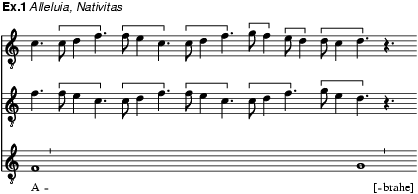
(fl Paris, c1200). Composer of organa, conductus and, probably, motets. He was almost certainly active at the cathedral of Notre Dame, Paris, and was the most important of the musicians involved in the revision and updating of the Magnus liber organi attributed to Leoninus. His achievements are mentioned in two documents from the late 13th century, the treatises of Johannes de Garlandia (Hieromymus de Moravia's compilation) and Anonymus 4. No works are ascribed to Perotinus in musical sources, but Anonymus 4 mentions seven of his compositions, all of which can be identified in manuscripts of the 13th and 14th centuries with reasonable certainty. Other compositions have been attributed to him on stylistic grounds by modern scholars.
EDWARD H. ROESNER
The identity of Perotinus is largely a matter of speculation. Circumstantial evidence points to his being at Notre Dame at the end of the 12th century and beginning of the 13th. Edicts reforming the celebration of the Circumcision Office (1 January) and the Feast of St Stephen (26 December) issued in 1199 by the Bishop of Paris, Eudes de Sully, mention performance of the Vespers responsory, the third and sixth Matins responsories, the gradual and alleluia of the Mass and the Benedicamus Domino ‘in triplo vel quadruplo vel organo’. Perotinus's four-voice settings of the graduals Viderunt omnes (for Christmas and Circumcision) and Sederunt principes (for St Stephen) are often dated on the basis of these edicts, although it is not improbable that they were in the repertory before Eudes' reforms, or even that one or both were composed in response to the edicts (if so, they would probably date from 1201 or later, owing to the papal interdict of 1200). Triplum and organum (duplum) versions of the other items on Eudes' list also appear in the Magnus liber, but these cannot be ascribed to Perotinus. However, one of Perotinus's conductus, Salvatoris hodie, is assigned to Mass on the Feast of the Circumcision in GB-Lbl Egerton 2615, and it is possible that this work stems from Eudes' reform. Perotinus appears to have worked with the poet Philip the Chancellor (d c1237); his conductus Beata viscera is a setting of Philip's poem, and some of his organa are found with motet texts that are also attributed to Philip.
The title ‘magister’, employed by both Johannes de Garlandia and Anonymus 4, indicates that Perotinus, like Leoninus, earned the magister artium, undoubtedly in Paris, and that he was licensed to teach. The diminutive form of his name, ‘Perotinus’ (for ‘Petrus’, a Latinization of the French ‘Pérotin’), was probably a mark of respect bestowed by his colleagues; the appellation ‘magnus’, used by Anonymus 4, testifies to the esteem in which he was held, even long after his death. If Perotinus's career was similar to those of other Parisian ecclesiastics involved with music, such as Adam of St Victor, Albertus Cantor, Leoninus and Philip the Chancellor, he could have held a prominent position within the cathedral hierarchy. In fact, Perotinus has been identified with two important members of the Notre Dame administration, the theologian Petrus Cantor (d 1197) and Petrus, Succentor of Notre Dame from 1207 or earlier until c1238. The first of these identifications is improbable from a chronological standpoint, but Petrus Succentor is a possible candidate, not least because of the role played by the succentor in overseeing the celebration of the liturgy in the cathedral. Husmann's hypothesis that Perotinus was associated with the parish church of St Germain-l'Auxerrois and that he was something of a court composer to the French king Philippe-Auguste is no longer accepted.
Virtually everything known about Perotinus's musical activity is extrapolated from a passage in the treatise of Anonymus 4 (ed. Reckow, 1967, i, 46). Noting that Leoninus, the optimus organista (‘best man with organum’), ‘made’ the Magnus liber to embellish the liturgy, he remarks:
[This liber] was in use up to the time of the great Perotinus, who made a redaction of it [‘abbreviavit eundem’] and made many better clausulas, that is, puncta, he being the best discantor, and better [at discant] than Leoninus was. … This Magister Perotinus made the best quadrupla, such as Viderunt and Sederunt, with an abundance of striking musical embellishments [colores armonicae artis]; likewise, the noblest tripla, such as Alleluia, Posui adiutorium and [Alleluia], Nativitas etc. He also made three-voice conductus, such as Salvatoris hodie, and two-voice conductus, such as Dum sigillum summi Patris, and also, among many others, monophonic conductus, such as Beata viscera etc. The book, that is, the books of Magister Perotinus, were in use in the choir of the Paris cathedral of the Blessed Virgin up to the time of Magister Robertus de Sabilone, and from his time up to the present day.
Crucial to an understanding of Perotinus's work is the meaning of the verb ‘abbreviare’ as used in the above passage. It could mean ‘to shorten’, and Anonymus 4's remark is often taken in that sense, as indicating that Perotinus shortened Leoninus's liber by curtailing the size of individual organa, replacing organum purum with discant clausulas and substituting one clausula for another. A group of 154 clausulas in I-Fl plut.29.1 (ff.178–83v, clausulas 289–442; ed. R.A. Baltzer, Le magnus liber organi de Notre-Dame de Paris, v, Monaco, 1995) could have been used to achieve this result; these clausulas have been ascribed to Perotinus by some modern scholars (see Ludwig, 1910; Waite, 1961; Sanders, 1967). However, most of the other clausulas in this manuscript (ff.147–84 v) are ambitious compositions, and their use in the organa would, if anything, expand the size of the original settings. A number of these clausulas bear a stylistic resemblance to the known works of Perotinus, which are also conceived on a large scale in comparison with the organa generally supposed to belong to the Leoninian corpus, and do not suggest a ‘reduction’ in any sense. ‘Abbreviare’ is probably better understood as meaning ‘to write down’ or ‘to make a redaction’; this reading is consistent with Anonymus 4's use of the word elsewhere in his treatise. If Perotinus ‘made a redaction of [Leoninus's liber]’, in effect he prepared a new ‘edition’ of it, a process that could have involved both ‘abbreviation’ and the introduction of ‘many better clausulas, that is, puncta’, as well as the addition of wholly new compositions. The idea of a redaction, or edition, accords with Anonymus 4's suggestion that Perotinus used a more developed system of rhythmic notation than Leoninus had, one in which the full system of rhythmic modes was operative, and in which some elements of mensural notation were present (‘These principles [of notation] are used in many books of the antiqui, and this from the time of the great Perotinus, and during his time, … and similarly from the time of Leo, to some extent [ pro parte!]’; ed. Reckow, 1967, i, 46). It also fits with his allusion to ‘the book, that is, the books of Magister Perotinus’, following immediately upon what is in effect a description of the Magnus liber as we know it from such manuscripts as D-W 628 and I-Fl plut.29.1. Ludwig (1910) suggested that the former manuscript transmitted the two-voice organa more or less as Leoninus had created them, and that (for the most part) its two clausula cycles date from the time of Perotinus, while the latter manuscript preserved the organa dupla in Perotinus's revision, in addition to much else by him. This formulation is undoubtedly too simple; the collections in both sources were certainly culled from several layers of the Notre Dame repertory, so that they reflect less the input of one specific composer or ‘editor’ than what was available to the scribe at the time of copying. But the Parisian origins of I-Fl plut.29.1, its close ties to Notre Dame and the fact that it was copied only a decade or two after Perotinus is likely to have been active, all suggest that this manuscript may indeed by the prime witness to his work.
We know from Anonymus 4 that Perotinus wrote organa for three and four voices, as well as conductus for one to three voices, and that he ‘made’ numerous ‘better’ clausulas, most of them presumably in two voices, for use in Leoninus's Magnus liber. Although Anonymus 4 refers to him as ‘optimus discantor’, implying that he was known in particular for his work in the various genres of discant, there is no reason to suppose that he did not compose organa dupla with passages in organum purum as well; indeed organum purum is a striking feature of his two four-voice organa. In any event, it is not possible to identify any organa dupla (or any sustained-note passages in such pieces) as his work. Perotinus probably also played a role in the early development of the motet. If, as seems likely, he was active through much of the first quarter of the 13th century or beyond, it is unlikely that he did not have direct contact with the new genre. Although Anonymus 4 does not ascribe any motets as such to Perotinus, this may be insignificant since although the theorist evidently knew the genre, he seems not to have taken it much into account in his treatise. Motet versions of Perotinus's two four-voice organa were included in E-Mn 20486 (and in reduced form in two other manuscripts, including the Parisian Magnus liber source D-W 1099); these texts are attributed elsewhere to Perotinus's collaborator and likely colleague at Notre Dame, Philip the Chancellor. In addition, several other organa and clausulas ascribed to Perotinus by modern scholars are also transmitted with motet texts written by Philip. Many early motets, including those that may be by Perotinus and Philip, were probably understood to be clausulas of sorts, and thus they may number among Perotinus's ‘many better clausulas, that is, puncta’ mentioned by Anonymus 4.
Perotinus's compositions for three and four voices are milestones in the history of Western music. With the possible exception of the three-voice conductus Congaudeant catholici ascribed to the Notre Dame cantor Albertus Parisiensis in the Codex Calixtinus, these are the first known pieces conceived for more than two independent parts. The upper voices often lie in a similar range and move in a similar style, frequently in phrases of identical length. This suggests that the polyphonic fabric may initially have been conceived in two parts, with additional voices being written in imitation of the second part or contrived from it. As ex.1 from Alleluia, Nativitas shows, each upper voice is written as a separate ‘duet’ with the tenor line, without much regard for the harmonic effect that these upper voices produce when combined. The polyphonic fabric is rooted in stable blocks of consonance, here based on f and, later, g, ordinarily built out of perfect concords, within which the upper voices intertwine to produce relatively frequent dissonant clashes. The use of dissonance within a consonant framework is cultivated with striking effect in the opening of Viderunt omnes (ex.2), where, after an intonation establishes the underlying consonant sonority, each phrase begins with a major 7th against the tenor in two or all three of the upper voices and then projects this discord forward in rhythmically energized polyphony before resolving it to a form of the initial concord. The tension generated by the prolongation of this dissonance significantly enhances the strength and formative power of the underlying consonance, allowing Perotinus to extend it over a very large span. Through the use of this and other stylistic elements Perotinus was able to create works on an unprecedented scale. This is doubtless one of the devices Anonymus 4 had in mind when he mentioned the quadrupla's ‘abundance of striking musical embellishments’. Another of the colores employed by Perotinus to enhance and extend his work was rondellus, or voice exchange; elements of this can be seen in exx.1 and 2, but in ex.3, from Sederunt principes, rondelli dominate the texture, yielding an extended variation design as the melodic ideas are passed from voice to voice. Still other colores are deployed to articulate the end of a clausula or larger work: in Alleluia, Nativitas a commonly used copula non ligata formula is inserted as a brief cadenza-like flourish to bring its setting of ‘alleluia’ to a close (ex.4).

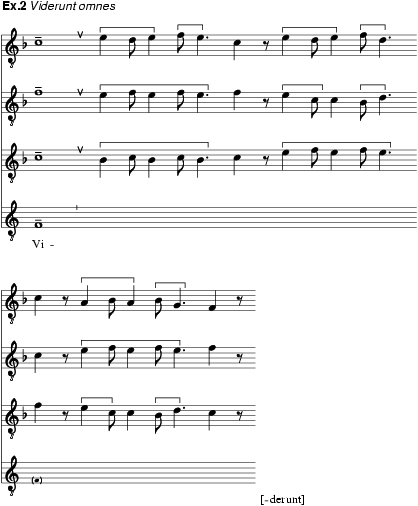
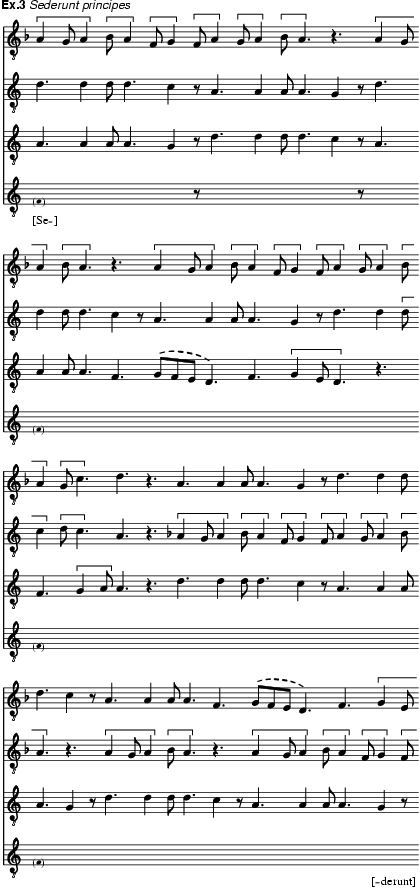
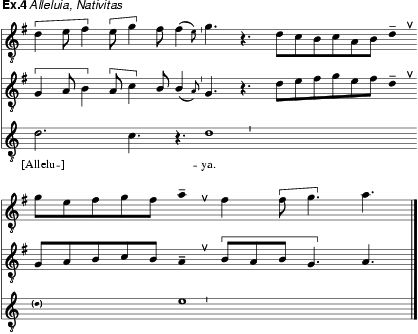
All of these devices reveal a composer keenly interested in clearly articulated structure and balanced design. The voice exchange in ex.3 shows a sensitivity to the possibilities inherent in the manipulation of multi-voice texture that belies the somewhat mechanical process that might seem to have been at work in creating the polyphonic fabric of ex.1. Perotinus often achieved formal shaping by balancing passages with differing textures. Above a sustained-note tenor, he sometimes deployed the upper voices in note-against-note fashion, but other times he differentiated them with individual rhythmic patterns in overlapping phrases, which generated a discant of sorts above the tenor in which one voice might move in the 5th rhythmic mode while another moves in 1st (ex.5, from Viderunt omnes). The systematic overlapping of rhythmic ordines in combination with the use of different rhythmic modes seen here is typical of many of the more ‘advanced’ two-voice clausulas. The developing sense of tonal balance which these examples display can be seen also on a much larger level in the formal design of entire settings (see Reckow, 1973; Flotzinger, 1984).
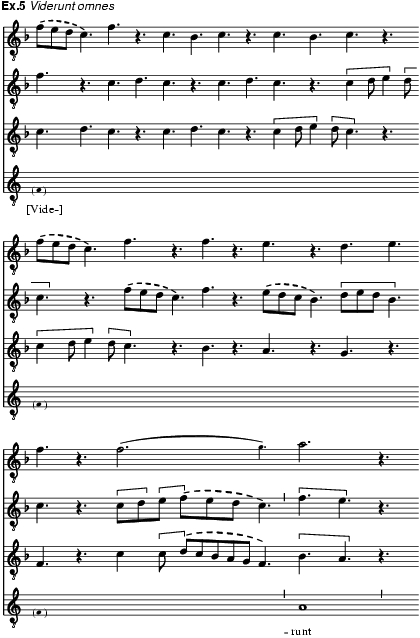
Unlike the organum purum in the two-voice settings in the Magnus liber, which usually flow in rhapsodic, wide-ranging, rhythmically ‘free’ melismas, the melodic idiom used by Perotinus in his sustained-note writing is highly disciplined, moving in balanced phrases with clearly defined, patterned rhythms of the sort codified in the system of rhythmic modes. Some works (e.g. the two four-voice organa) limit their rhythmic designs to the 1st, 5th and 6th modes, and to variations of them such as the so-called alternative form of the 3rd mode. Others, such as Alleluia, Nativitas and Alleluia, Posui adiutorium, however, draw upon the full range of temporal relationships inherent in the six modal patterns. Since the three ‘trochaic’ modes (1, 5 and 6) are probably earlier than the others, it is sometimes thought that these distinctions in rhythm usage reflect different stages in the evolution of Perotinus's style. But in fact all of his organa were conceived against the background of the fully developed modal system. Thus Viderunt omnes and Sederunt principes include hocketing passages in the ‘imperfect’ 1st mode, while the most ‘advanced’ of his organa (with the greatest degree of rhythmic variety), Alleluia, Posui adiutorium, is cited by Anonymus 4 for a passage in the 1st ‘irregular’ mode (ed. Reckow, 1967, i, 84). In their rhythmic clarity and precision these organum purum lines are similar to Perotinus's discant writing, and may be one of the factors prompting Anonymus 4's characterization of him as ‘optimus discantor’. The rhythmic patterning reduces the stylistic disparity between organum purum and discant clausulas within a larger setting, and thereby heightens the unity of the work as a whole. Nonetheless, something of the florid quality of Leoninus’s lines can be detected in the cadential gesture in ex.5, and, using a slightly different vocabulary, in the melodic embellishments applied to individual syllables in Perotinus's conductus and the flourishes that conclude the melismatic caudae placed at important structural points in the text (ex.6, the beginning and end of the first strophe of Salvatoris hodie).

As the opening of Beata viscera shows (ex.7), the strong sense of tonal order and the balanced melodic phrases to which it contributes, manifest throughout Perotinus's works for two or more voices, also inform his monophony, despite the absence of the formative constraints of a polyphonic texture and clearly perceptible modal rhythm. This tendency towards lucidity, order and balance, equally evident in the melodic profile, the phrase structure, the rhythmic planning or the harmonic idiom of the music, would become an important feature not only of much later French music, but also of 13th-century English polyphony, most strikingly in the Summer Canon and the repertory in the Worcester Fragments.

See also Magnus liber; Rhythmic modes; Sources, MS, §IV, 4.
|
† |
compositions cited by Anonymus 4 as by Perotinus; all other works are attributed by Husmann on stylistic grounds |
Editions:Polyphonies du XIIIe siècle: le manuscrit H 196 de la Faculté de médecine de Montpellier, ed. Y. Rokseth (Paris, 1935–9) [R]Die drei- und vierstimmigen Notre-Dame-Organa: Kritische Gesamtausgabe, ed. H. Husmann, Publikationen älterer Musik, xi (Leipzig, 1940/R) [complete except for conductus]Thirty-five Conductus for Two and Three Voices, ed. J. Knapp, Collegium musicum, vi (New Haven, CT, 1965) [K]The Works of Perotin, ed. E. Thurston (New York, 1970) [T]The Montpellier Codex, ed. H. Tischler, RRMMA, ii–viii (1978–85) [M]Notre-Dame and Related Conductus: Opera omnia, ed. G.A. Anderson (Henryville, PA, 1979–) [A]The Conductus Collections of MS Wolfenbüttel 1099, ed. E. Thurston, RRMMA, xi–xiii (1980) [C]The Earliest Motets (to circa 1270): a Complete Comparative Edition, ed. H. Tischler (New Haven, CT, 1982) [E]Les quadrupla et tripla de Paris, ed. E.H. Roesner, Le magnus liber organi de Notre-Dame de Paris, i (Monaco, 1993) [complete except for conductus]
|
†Viderunt omnes V. Notum fecit dominus, T, E (gradual for Christmas and Circumcision; motet versions: Vide prophecie and Homo cum mandato dato; texts have medieval attrib. Philip the Chancellor) |
|
†Sederunt principes V. Adiuva, T, E (gradual for St Stephen; motet versions: De Stephani roseo sanguine and Adesse festina; texts have medieval attrib. Philip the Chancellor) |
|
Sancte Germane V. O sancte Germane, R (resp for St Germanus and other confessor bishops; motet version: Associa tecum in patria; text has medieval attrib. Philip the Chancellor) |
|
Terribilis V. Cumque (resp for Dedication of a Church) |
|
Virgo V. Sponsus, R (resp for St Catherine) |
|
Exiit sermo V. Sed siceum (gradual for St John the Evangelist) |
|
Alleluia, Pascha nostrum (Easter) |
|
†Alleluia, Nativitas, R, T, E (Nativity of BVM motet version of the clausula on Ex semine: Ex semine rosa prodit spina/Ex semine Abrahe divino; text attrib. Philip the Chancellor by modern scholars) |
|
Alleluia, Dilexit Andream (St Andrew) |
|
†Alleluia, Posui adiutorium, R, T (commune sanctorum for Confessor-Bishops) |
|
Benedicamus Domino (i) |
|
Benedicamus Domino (ii) |
|
Benedicamus Domino (iii) |
|
Mors, 4vv, E (for Alleluia, Christus resurgens; motet version: Mors que stimulo/Mors morsu nata venenato/Mors a primi patris; text attrib. Philip the Chancellor by modern scholars) |
|
In odorem, 3vv, E (for Alleluia, Dilexit Andream; motet version: Mens fidem seminat/In odorem; text attrib. Philip the Chancellor by modern scholars) |
|
Et illuminare, 3vv, E (for gradual Omnes de Saba V. Surge; motet versions) |
|
Et gaudebit, 3vv, E (for Alleluia, Non vos relinquam; motet version: Homo qui vigeas/Et gaudebit; text attrib. Philip the Chancellor by modern scholars) |
|
Et exaltavi, 3vv, E (for Alleluia, Posui adiutorium; motet version: Et exaltavi plebis humilem/Et exaltavi; text attrib. Philip the Chancellor by modern scholars) |
|
Numerous 2-voice clausulas (attrib. by Ludwig, 1910; Waite, 1961; Sanders, 1967) |
|
†Salvatoris hodie, 2vv and 3vv, K, T, A, C |
|
†Dum sigillum summi Patris, 2vv, K, T, A |
|
†Beata viscera, 1v, T, A, C (text has medieval attrib. Philip the Chancellor) |
MGG1(H. Husmann; also ‘Ars Antiqua’, H. Besseler; ‘Notre-Dame-Epoche’, H. Husmann)
F. Ludwig: ‘ Die liturgischen Organa Leonins und Perotins’, Riemann-Festschrift (Leipzig, 1909/R), 200–13
F. Ludwig: Repertorium organorum recentioris et motetorum vetustissimi stili, i/1 (Halle, 1910/R), 15–16, 23ff, 60
F. Ludwig: ‘ Perotinus Magnus’, AMw, iii (1921), 361–70
A. Gastoué: Les primitifs de la musique français (Paris, 1922)
R. von Ficker, ed.: Perotinus: Organum quadruplum Sederunt principes (Vienna and Leipzig, 1930)
J. Handschin: ‘ Zur Leonin-Perotin-Frage’, ZMw, xiv (1931–2), 319–32
J. Handschin: ‘ Zur Geschichte von Notre Dame’, AcM, iv (1932), 5–17, 49–55, 104–5
H. Schmidt: Die drei- und vierstimmigen Organa (Kassel, 1933); part previously pubd as ‘Zur Melodiebildung Leonins und Perotins’, ZMw, xiv (1931–2), 129–34
Y. Rokseth, ed.: Polyphonies du XIIIe siècle: le manuscrit H 196 de la Faculté de médecine de Montepellier, iv (Paris, 1939), 48–62
H. Husmann: Introduction to Die drei- und vierstimmigen Notre-Dame-Organa, Publikationen älterer Musik, xi (Leipzig, 1940/R)
Y. Rokseth: ‘ La polyphonie parisienne du treizième siècle: étude critique à propos d'une publication récente’, Les cahiers techniques de l'art, i/2 (1947), 33–47
F. Gennrich: ‘ Perotins Beata viscera Mariae virginis und die “Modaltheorie”’, Mf, i (1948), 225–41
H. Tischler: ‘ New Historical Aspects of the Parisian Organa’, Speculum, xxv (1950), 21–35
F. Gennrich, ed.: Perotinus Magnus: Das Organum Alleluja Nativitas gloriose virginis Marie und seine Sippe, Musikwissenschaftliche Studien-Bibliothek, xii (Darmstadt, 1955)
A. Machabey: ‘ A propos des quadruples pérotiniens’, MD, xii (1958), 3–25
W.G. Waite: ‘ The Abbreviation of the Magnus liber’, JAMS, xiv (1961), 147–58
G. Birkner: ‘ Notre Dame-Cantoren und -Succentoren vom Ende des 10. bis zum Beginn des 14. Jahrhunderts’,In memoriam Jacques Handschin, ed. H. Anglès and others (Strasbourg, 1962), 107–26
H. Husmann: ‘ St. Germain und Notre-Dame’, Natalicia musicologica Knud Jeppesen septuagenario collegis oblata, ed. B. Hjelmborg and S. Sørenson (Copenhagen, 1962), 31–6
H. Husmann: ‘ The Enlargement of the Magnus liber organi and the Parish Churches St. Germain l'Auxerrois and Ste. Geneviève-du-Mont’, JAMS, xvi (1963), 176–203
H. Husmann: ‘ The Origin and Destination of the Magnus liber organi’, MQ, xlix (1963), 311–30
H. Tischler: ‘ The Dates of Perotin’, JAMS, xvi (1963), 240–41 [response to E.H. Sanders' article, JAMS, xv, 1962, pp.249–91, esp. 280]
H. Tischler: ‘ Perotinus Revisited’, Aspects of Medieval and Renaissance Music: a Birthday Offering to Gustave Reese, ed. J. LaRue and others (New York, 1966/R), 803–17
H. Tischler: ‘ The Early Cantors of Notre Dame’, JAMS, xix (1966), 85–7
F. Reckow, ed.: Der Musiktraktat des Anonymus 4 (Wiesbaden, 1967), esp. i, 45–6, 99–102
E.H. Sanders: ‘ The Question of Perotin's Oeuvre and Dates’, Festschrift für Walter Wiora, ed. L. Finscher and C.-H. Mahling (Kassel, 1967), 241–9
J. Chailley: Histoire musicale du moyen age (Paris, 2/1969), 158–61
R. Flotzinger: Der Discantussatz im Magnus liber und seiner Nachfolge (Vienna, 1969)
F. Reckow: ‘ Das Organum’, Gattungen der Musik in Einzeldarstellungen: Gedenkschrift Leo Schrade, ed. W. Arlt and others (Berne and Munich, 1973), 434–96, esp. 478–81
E.H. Sanders: ‘ The Medieval Motet’, ibid., 497–573
R.A. Baltzer: Notation, Rhythm, and Style in the Two-Voice Notre-Dame Clausula (diss., Boston U., 1974)
S. Brunner: Die Notre-Dame-Organa der Handschrift W2 (Tutzing, 1982)
H. Tischler: ‘ Pérotin and the Creation of the Motet’, MR, xliv (1983), 1–7
P. van Poucke: Magister Perotinus magnus: Organa quadrupla generaliter, inleidende reconstructieve Studie (diss., Rijksuniversitett Gent, 1983)
R. Flotzinger: ‘Zu Perotin und seinem “Sederunt”’, Analysen: Beiträge zu einer Problemgeschichte des Komponierens: Festschrift für Hans Heinrich Eggebrecht zum 65. Geburtstag, ed. W. Breig, R. Brinkmann and E. Budde (Wiesbaden, 1984), 14–28
R. Flotzinger: ‘“De Stephani roseo sanguine”: vom Quadruplum zur einstimmigen Motette’, Mf, xxxvii (1984), 177–90
T.B. Payne: ‘ Associa tecum in patria: a Newly Identified Organum Trope by Philip the Chancellor’, JAMS, xxxix (1986), 233–54 [incl. edn]
R. Stelzle: Der musikalische Satz der Notre Dame-Conductus (Tutzing, 1988)
C. Wright: Music and Ceremony at Notre Dame of Paris, 500–1500 (Cambridge, MA, 1989), esp. 288–94
T.B. Payne: Poetry, Politics and Polyphony: Philip the Chancellor's Contribution to the Music of the Notre Dame School (diss., U. of Chicago, 1991)
Perotinus Magnus, Musik-Konzepte, no.107 (2000)
S. Pinegar: ‘ Between Pope and Monarch: The Edicts of Eudes de Sully Concerning Liturgical Polyphony at the Cathedral of Notre Dame, Paris’ (forthcoming)